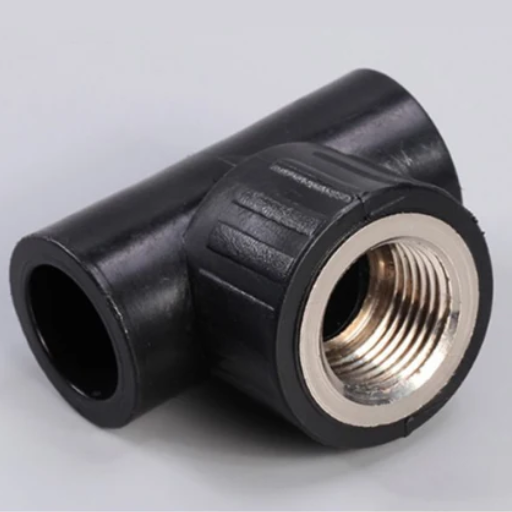Welcome to our complete guide about HDPE pipe fittings, focusing on the HDPE socket fusion female tee. This versatile fitting will be briefly discussed in this write-up, and its key features, merits, and applications will be highlighted. Several factors have necessitated the popularity of high-density polyethylene (HDPE), a durable material that withstands harsh weather conditions and is ideal for plumbing, construction, and industrial applications. By the end of this review, you will know what HDPE socket fusion female tees are, how they are installed, and the best ways to ensure optimum performance during your work. This article aims to provide helpful insights and practical knowledge for DIY enthusiasts and seasoned professionals.
What is an HDPE Socket Fusion Female Tee?
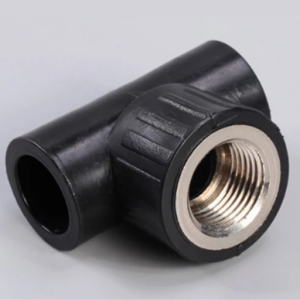
Image source: https://sdplasticpipe.en.made-in-china.com/
An HDPE socket fusion female tee refers to one type of pipe fitting used to join three pieces of high-density polyethylene (HDPE) pipes at right angles. A Female Tee with a socket design on its ends allows for the simple insertion of pipe pieces, thereby making tight connections without any leakage. Initially, both ends of the pipe and fitting are heated to a specific temperature under the socket fusion process before cooling them together, forming a solid bond that cannot be broken easily. In most cases, it is utilized in plumbing, such as irrigation systems, where fluid distribution must be maintained efficiently.
Definition of HDPE Socket Fusion
The process I use to connect high-density polyethylene pipes and fittings is called HDPE socket fusion. The ends of the pipe and the fitting are heated until they reach the melting point, pressed together as they cool to make an enduring bond. Its ability to create joints that do not leak but still preserve the quality of the material, making it suitable for various applications that require flow optimization and pressure maintenance, has made this method very popular. I think it is beneficial in settings that emphasize their dependability and sturdiness. Such cases include plumbing work and irrigation systems.
Components of a Female Tee
Socket pieces or HDPE socket fusion female tee parts have a few primary components: the tee body, sockets, and pipe connections. The primary purpose of the tee body is to act as a central part that allows for a three-way connection. Each socket accommodates HDPE pipes by providing tightness between them. These sockets are made with a specific inner diameter that matches the outer diameter of each pipe so that efficient fusion can occur. Additionally, I ensure that the materials used are high-density polyethylene (HDPE) because they possess excellent resistance to corrosion and impact, making them suitable for various applications over time.
Applications of HDPE Pipe Fittings
My experience has taught me how versatile HDPE pipe fittings can be, as there are numerous areas where they come in handy across different industries. For instance, in water distribution systems where they form watertight connections, thereby ensuring smooth, uninterrupted water flow, I often integrate them into my designs, which facilitate optimal efficiency(through) this waterproofing feature what’s more (or in addition). Also, fittings like these find extensive use in agricultural irrigation systems owing to their durability plus resistance against chemicals and UV rays’ effects. While working in the industry, I prefer using HDPE since it transports different liquids or gases due to their strength and corrosion resistance, among others. All these now become clear why HDPE fittings continue being widely used in various engineering products, systems, and installations ranging from infrastructure objects to sewage lines and environmental ponds, as they tend to increase the duration of operation and workability of materials I deal with.
How Does an HDPE Socket Fusion Female Tee Work?
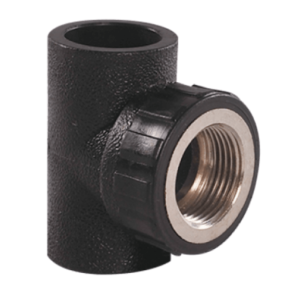
HDPE socket fusion female tee operates via heat fusion, producing a robust and seamless connection between the pipes and the fitting. At first, the tool heats the end of HDPE pipes and those sockets on the tee until it attains the right temperature for joining. While still soft, they are hammered into these sockets and quickly merge upon cooling. Consequently, this results in these connections that never leak under high pressure and changing temperatures. The design of female tees enables three-way joints; thus, it is efficient in branching out systems.
Mechanism of Socket Fusion
In my undertaking of socket fusion procedures, I ensure that both surfaces of HDPE pipes and fittings are free from dirt and contaminants. Subsequently, using heating or a fusion tool, I heat both ends of the pipe as well as fitting to reach some given temperature, which usually varies between 400°F to 450°F (204°C to 232°C). I interlock them together when they get such temperatures while still in their softened condition with a slight twist for better adhesion. A strong joint is formed after keeping them excellent at their positions. This method guarantees good resistance against pressure and leakage; hence, it becomes integral to my work when handling HDPE piping projects.
Advantages of Using HDPE Material
HDPE offers several advantages (High-density polyethylene) that make it preferable to many other materials used in various piping applications.
- Durability and Resistance: Its resilience to harsh environments, impact forces, and chemicals extends its service life considerably more than alternatives with different attributes, including corrosion-resistant properties.
- Lightweight and Easy Installation: It is lighter than other elements, such as metallic or concrete ones, making it easier to handle during installation processes. This means fewer labor charges and simplified movement requirements for transportation reasons.
- Flexibility and Versatility: Other factors include how thick an individual sheet can be made since one may need to make several design adjustments along the way.
- Cost Effectiveness: HDPE’s longevity and reduced need for maintenance reduce the overall expenditure of building infrastructure projects, making it the most economical decision.
- Environmental Impact: In addition, its production normally requires very little energy compared to most traditional materials, hence being seen as a more ecological approach.
Due to these combined advantages, HDPE is now being used in numerous applications specific to agriculture, municipal facilities, and industries.
Steps to Fuse HDPE Pipes
HDPE pipe fusion is a meticulous process requiring attention to every detail for desired outcomes. This is how I go about it:
- Get the Tools and Materials: To begin with, I verify that all required equipment is in place, including a fusion machine, pipe ends to be joined, and safety clothing such as gloves and goggles.
- Prepare the Pipe Ends: To achieve a strong bond between the HDPE pipes, you must clean the ends of these pipes using a piece of cloth to remove dirt or dust.
- Heat the Pipe Ends: Next, I put them into a heating element on my fusion machine so that they heat up evenly. The time depends on the diameter of your pipes, but normally, this takes about 30 seconds to one minute at temperatures around 220°C (428°F).
- Join the Pipe Ends: When they get pliable enough, I quickly remove them from the heat and accurately line their edges before pressing them together at an appropriate force level to give me dependable connections.
- Cooling Time: I let the jointed section cool for at least 30 minutes without any disturbance. Then, its outward surface will be examined for detectable flaws or irregularities.
Through these steps, my HDPE pipe fusions would be strong and reliable, resulting in efficient piping systems without any leaks.
What are the Benefits of HDPE Socket Fusion Fittings?
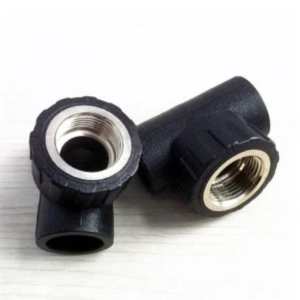
HDPE socket fusion fittings have many advantages, making them preferable to other types in different piping systems. First, they ensure there is no leaking, making it less likely for problems and costlier repairs. Socket fusion also requires few tools; hence, faster installations can be done than other methods. They are also corrosion-resistant and can endure harsh chemicals, meaning such pipes last long, even under challenging conditions. Further still, their ability to fit various sizes and shapes of pipes allows them to be used everywhere, including the agriculture sector and municipal use cases. Therefore, HDPE socket fusion fittings play a significant role in creating robust and reliable piping systems.
Durability and Strength
HDPE socket fusion fittings are some of the most demanding and muscular fittings suitable for heavy applications. HDPE is known to have high tensile strength and good impact resistance; hence, it does not become brittle or degrade even in extreme environments. The material has inherent resistance to many corrosive substances, thus making the material ideal for underground and industrial installations. Moreover, the socket fusion method creates a fluid space that improves the overall structural integrity of the pipeline system, thus minimizing future leaks or failures. In general, HDPE fittings are built to last longer, ensuring reliable service in different settings.
Corrosion Resistance
As noted from my own experiences with this type of fitting, HDPE socket fusion fittings possess excellent protection against corrosion, making them an option I would recommend for various uses. Moreover, unlike metallic fittings, HDPE does not corrode or rust when exposed to harsh chemicals such as acids or bases; hence, it is used when everyday materials are worn out. This inherent resistance extends these products’ useful life while reducing maintenance costs and expenses on their substitution over time. I discovered that toughness and chemical stability make HDPE a dependable choice for maintaining pipe systems under harsh circumstances.
Cost-Effectiveness
I believe the affordability of HDPE socket fusion fitting is one significant advantage that differentiates them from conventional materials. Even if there may be a slightly higher initial cost, very minimal maintenance requirements coupled with durability lead to substantial long-term savings in terms of money spent on replacements or repairs. HDPE fittings have lower life cycle costs because they can withstand corrosion and wear over time, reducing instances that call for replacing or repairing them. Additionally, joints made through socket fusion are seamless; hence, there is no scope for such leaks in the future, leading to lesser expenses related to system failures as we advance. In conclusion, any piping system must consider these economics regarding long-term performance guarantees about the quality and durability of HDPE fittings.
How to Choose the Right HDPE Socket Fusion Female Tee?
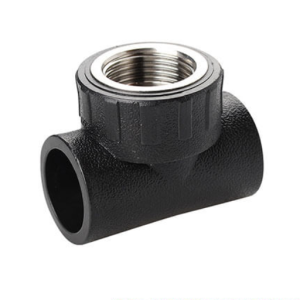
When choosing an HDPE socket fusion female tee, several vital factors should be considered. The first is to evaluate specific operational details, including pipe system sizing and required pressure ratings. In addition, it is essential to ensure compatibility with existing materials and fittings for trouble-free installations. Any other fittings certified by industry standard bodies can be looked for because this connotes trustworthiness and good quality products. Moreover, you might need to know about the manufacturer’s reputation alongside warranty provisions, which may help you see if they are dependable. Finally, weigh up the economics of the initial costs against future maintenance savings and durability to arrive at a prudent choice.
Understanding PN16 and PE100 Ratings
PN16 is a term used to describe the nominal pressure rate of thermoplastic pipes and fittings, which shows that such a fitting can hold at most 16 bars (about 232 psi) at 20°C. This value ensures that the system remains operable under pressure without bursting. On the contrary, PE100 is an HDPE material classification that denotes its exceptional strength, long life expectancy, and resistance to various natural conditions. These PE100 materials are intended for extended periods in challenging circumstances, including water supply areas and industrial premises. As such, using a PN16 fitting made from PE100 ensures high-performance standards coupled with reliability thus enabling their utilization in multiple piping systems.
Selecting the Correct SDR11 Specification
I focus on critical factors when choosing the correct SDR11 specification for my piping system. First, I consider the desired use of the plumbing and its pressure requirements. It has a standard dimension ratio (SDR) of 11, which balances the pipe’s capacity to hold pressure and thickness, making it a favorite in different water and wastewater systems. Secondly, I verify if that material is compatible with the existing network, particularly when incorporating new pipes into old ones. Subsequently, I check for certifications that prove the quality and durability of SDR11 pipes, such as those given by industry standards organizations. Finally, I consider the long-term cost implications, ensuring that although the initial costs might be high, the life span and reduced maintenance needs for SDR11 pipelines will result in savings.
Compatibility with Other Pipe Fittings
The compatibility with other pipe fittings should be evaluated so that the materials used match to prevent leaks and maintain structural integrity. For instance, while using PE100 pipes, I ensure their fittings are also HDPE-made to ensure chemical and thermal compatibility. For this reason, I also pay close attention to the dimensions and pressure ratings of these fittings to ascertain whether they still fit within SDR11 specifications. It is crucial because system failures can result from mismatched sizes or ratings. The selection also involves considering coupling methods like butt fusion or electrofusion, which will serve well in attaching new fittings to existing infrastructure. All these considerations are essential for having an efficient piping system.
Where Can You Buy Quality HDPE Socket Fusion Female Tees?
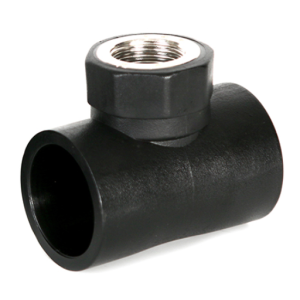
There are numerous places to buy high-quality HDPE socket fusion female tees. Many local plumbing supply stores have a variety of high-density polyethylene fittings, including female tees. Online retailers such as Amazon, Grainger, and unique plumbing sites sell HDPE fittings with detailed specifications for more choices. It is also a good idea to contact the manufacturers directly because they might sell in bulk and provide guarantees on their products. Trade shows and industry expos are great for sourcing new suppliers and comparing quality directly.
Top Suppliers and Manufacturers in China
When I need reliable Chinese suppliers of high-quality HDPE socket fusion female tees, I often consider several reputed producers. One company that fits into this category is Zhangjiagang Dingtian Pipe Industrial Co., Ltd., which has an extensive range of HDPE fittings and strict adherence to quality standards. Alternatively, one can look up Zhejiang Hongjia Plastic Industry Co., Ltd., which offers attractive prices and sound production facilities. Lastly, Shandong Wiskind Steel Building Stock Co., Ltd.’s designs are highly innovative, and the customer services department provides all-around assistance for a diverse clientele base. These assessments enable me to obtain dependable, high-standard fittings for my projects.
Factors to Consider When Purchasing
When acquiring the HDPE socket fusion female tees, I go through various things to decide what to purchase from them. First and foremost, the material quality ensures that these fixtures are made of durable high-density polyethylene as per industry standards that will not wear out quickly, even when exposed to chemicals like acids or bases used in plumbing practices. Secondly, it’s vital to assess a manufacturer’s reputation by checking client reviews across different websites because this helps me know how reliable they are, plus their level of customer service provision. Other features like pressure ratings and system compatibility must be checked before using such parts. Lastly, comparing prices from different suppliers is a good thing to do where warranties and discounts for bulk purchases are available.
Ensuring Competitive Pricing
I will initially review Google for top suppliers’ rates and deals to obtain the most competitive prices when buying HDPE socket-fused female tees. By comparing quotes from at least three well-known vendors, I can get the average price range and steer clear of overcharges. Additionally, I check out websites with advertisements on bulk order discounts and promotional deals. This way, I remain updated on seasonal sales or special offers to facilitate the acquisition of first-class fittings at reasonable prices.
How do you install an HDPE socket Fusion female tee?
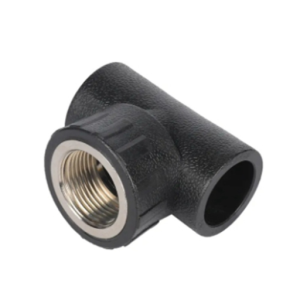
Sealing an HDPE socket fusion female tee necessitates several essential steps. The initial step is to cut the HDPE pipe ends that will be joined into the tee using straight, clean cuts. Thereafter, one should use an appropriate cleaning solution or cloth to wipe off any dirt or debris from both the pipe surfaces and fitting sockets.
The fitting’s sockets and pipe ends are heated concurrently in a socket fusion machine until they attain their ideal temperature, generally around 220-240°C (428-464°F). An electrically heated pipe is rapidly put inside a female tee socket, ensuring it is inserted fully into it. Allow this connection to cool and solidify for some seconds before removing hands. Finally, inspecting a joint for any misalignment or gaps is necessary after curing has taken full effect as per the manufacturer’s instructions to reinforce it before testing begins.
Required Tools and Equipment
I must gather specific tools and equipment to install an HDPE socket fusion female tee. First, a socket fusion machine is required to heat the pipes and fittings. I also set aside a pipe cutter and tape measure to accurately cut and fit the HDPE pipes. Additionally, the surfaces of the fittings and pipes are prepped using a cleaning solution and cloth. Furthermore, safety gear such as gloves and goggles is essential during the fusion process due to the high temperatures involved. Lastly, I may have to use a temperature gauge to monitor my progress in reaching fusion temperatures.
Step-by-Step Installation Guide
- Preparation and Safety: Ensure you have all the necessary tools and gear, like gloves and goggles. Work in an area with enough ventilation.
- Measurement and Cutting: Mark where you need to cut on the HDPE pipe. Utilize a pipe cutter to ensure clean, straight cuts, enhancing proper fusion.
- Surface Cleaning: Use a good cleaning solution to remove dust and dirt from both surfaces of the pipes and fittings.
- Heat Application: Adjust your socket fusion machine’s temperature range (220-240°C or 428-464°F). While at it, ensure that you heat inside a fitting too.
- Joining the Components: Insert your pipe into a fitting socket fast immediately after both reach the ideal temperature.
- Cooling and Inspection: Hold still for a few seconds after completion so that it cools down fully. After cooling down, check whether there was improper joining or misalignment.
- Curing: Curing allows the bond between fused ends to gain full strength before any pressure can be introduced according to the manufacturer’s instructions, thus preserving the integrity of jointed parts.
Observing these steps correctly ensures the successful installation of an HDPE socket fusion female tee.
Common Installation Mistakes to Avoid
When installing an HDPE socket fusion female tee, it is essential to be wary of some mistakes that can weaken the joint. Primarily, I should prevent hastening the heating process, failing to get the fitting and pipe to achieve sufficient temperatures results in weak fusions which may eventually lead to failure of joints. Also, one must confirm that surfaces are clean and free from contaminants such as dirt or grease as they hinder proper adhesion. Finally, before relocating or applying pressure on a joint, I must allow it to cool adequately; excessive movements during the cooling stage may lead to misalignment or weaken the bond. Through this awareness level, I increase the quality and longevity of my installation.
Reference sources
- Socket Fusion Tees – HDPE Supply
- HDPE Socket Fusion Fittings – DEF Pipeline
- HDPE Socket Fusion Fittings Female Tee PE100 PN16 – CD Chuangrong
Related Articles: Applications of HDPE Socket Female Tee



